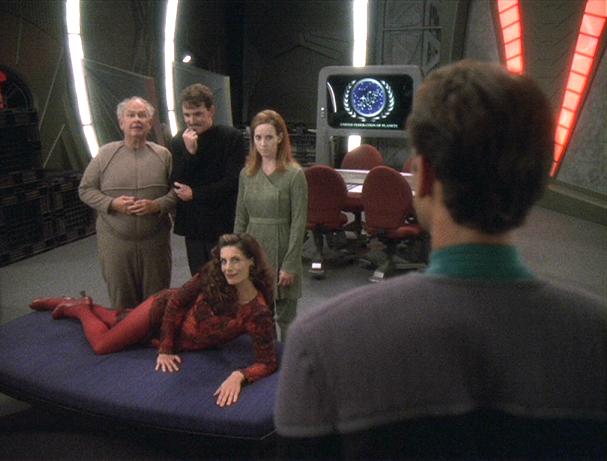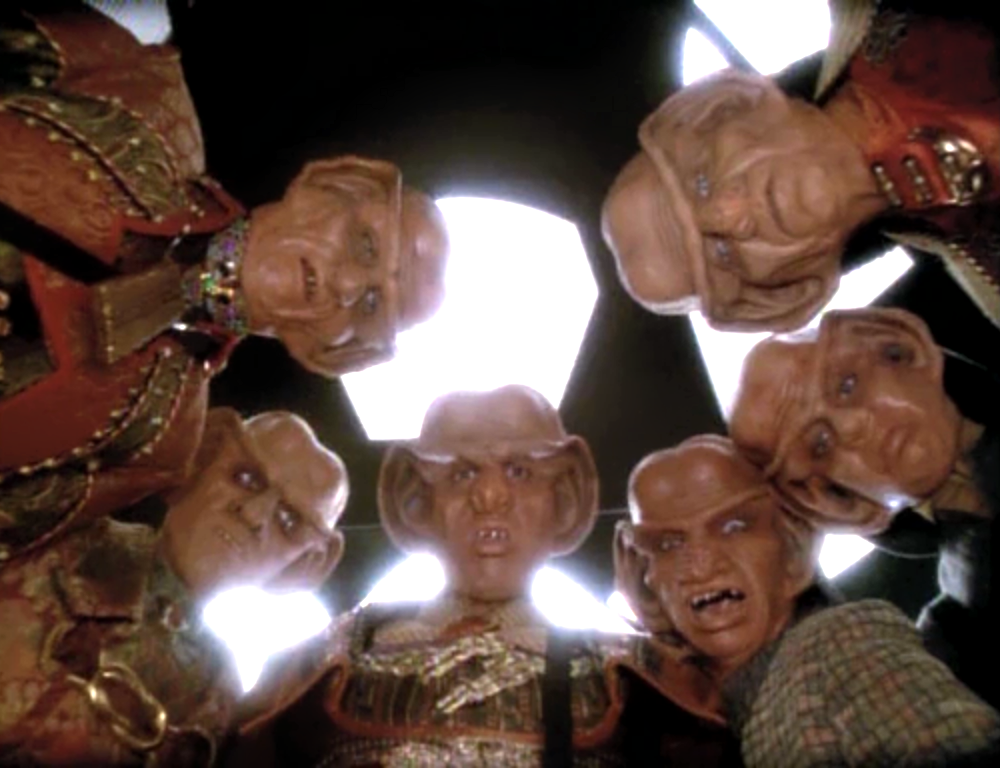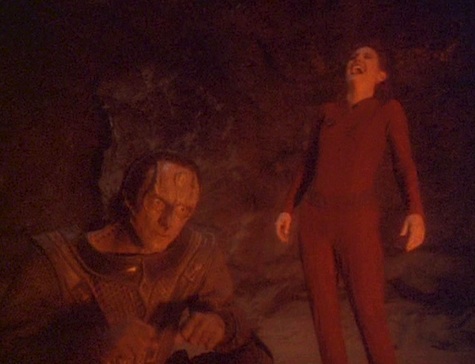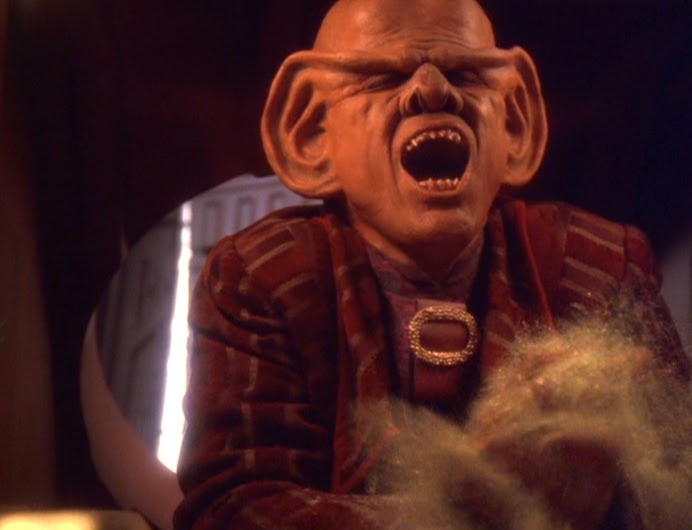“STATISTICAL PROBABILITIES”

“Wanna hang with the not-so-cool kids?”
“Statistical Probabilities” marks a welcome return to form following the previous episode’s misfire. I particularly love the way it integrates an initially small-scale and refreshingly offbeat story with the show’s overarching narrative.
When the season’s opening arc concluded with “Sacrifice of Angels”, I initially expected the Dominion war to end there and then. I had no idea the writers would keep the war storyline going for the duration of the show’s run. Don’t get me wrong, I’m glad they did, because there was certainly a whole lot more to be mined from it. However, they now had a delicate balancing to perform. How would they maintain an ongoing war arc while returning to predominantly episodic stories centring on self-contained character drama? Too much focus on the war would have engendered too bleak a tone for a Star Trek series (indeed, one of the reasons I’ve never felt compelled to rewatch the Battlestar Galactica reboot was precisely that unrelentingly bleakness) and too little would render it unconvincing and half-assed. This episode strikes a good balance. It begins as an isolated character piece and then branches out to tackle the very fate of the Alpha Quadrant, demonstrating just how tough the situation is without having to show a single shot being fired.
Something else the episode does well is to introduce of a vivid group of characters unlike any we’ve ever really met in the Star Trek universe before. A number of years ago, I worked in social care helping adults with learning needs and I have to say this episode isn’t altogether inaccurate in its depiction of what I think now gets termed “neuro-divergent” people. Jack, in particular, is a well-realised character, and Tim Ransom does a superb job bringing him to life; from his manic demeanour, to the volatile bursts of emotion and aggression underscored by often misdirected intelligence. The other characters are painted with broader strokes yet they’re also effective to varying degrees. Michael Keenan captures Patrick’s childlike innocence perfectly and Faith C. Salie does a great job as the catatonic Serena, managing to convey a great deal of depth with her eyes alone. Hilary Shepard Turner also triumphs as Lauren, even though the script doesn’t give her a whole lot to work with other than cliched “sex maniac”. It seems lazy on the part of the writers to root Lauren’s entire character in her hyper-sexuality (particularly as this comes straight after another episode featuring the sex-crazed Intendant), but there you have it. While I love DS9’s writing staff to bits, quite often the lack of a female writer on staff shows.
Anyway, the premise is nicely set up and provides a welcome follow-up to the previous season’s “Doctor Bashir, I Presume?” Again, I’d half-expected the revelation about Bashir’s genetic enhancement to be shunted to the background following that episode and never really explored again. After all, that’s what generally happened in Star Trek, so I was, once again, delighted to be proven wrong. Writers Pam Pietroforte and Rene Echevarria raise some interesting questions about the role of genetic engineering in the Trek universe and the Federation’s treatment of these people certainly raises an eyebrow. I found it interesting that our guests were kept in a cargo bay rather than assigned quarters, almost giving the subconscious impression that they are seen more as objects than people.
It’s great fun watching them become utterly absorbed analysing Damar’s speech and, of course, Bashir quickly gets involved in their staggeringly detailed projections on the outcome of the war. There’s an excellent scene in Sisko’s office where the Captain basically pours cold water over Bashir, refusing to accept his projections as anything other than educated guesswork. Initially, I assumed the episode’s theme related to how even the most marginalised of people can prove their worth and contribute to society. Of course, all that falls through and the ultimate message turns out to be that even the smartest of people can be wrong. Indeed, with all their genetically engineered genius, I seriously doubt Jack and friends would ever have been able to predict the role the Prophets played in defeating the Dominion fleet and allowing Sisko the retake the station. No matter how smart you are, and how informed your arguments, there’s simply no way to accurately predict the future. Life is beset with countless hidden variables that can never be accounted for.
On other fronts, it was great to see the return of Damar and Weyoun, and Casey Biggs is particularly impressive as a man who is clearly unhappy at being appointed as the new head of the Cardassian government. It’s certainly not a role he seems suited for, and I suspect a large part of the reason he was appointed is that Weyoun can control and coerce him, as we see here. Not that I have any sympathy for him at this point given that his brutal and unnecessary murder of Ziyal is still fresh in our minds. It’s the start of an absolutely fascinating and highly effective character arc, however.
I think that about covers it. “Statistical Probabilities” is a thought-provoking and, for the most part, intelligently written episode with some interesting themes and twists. There’s a nicely offbeat tone to the first few acts in particular, as exemplified by the gloriously surreal cargo bay waltz to “The Blue Danube”. It’s refreshing to see a bunch of characters who don’t fit the 24th century mould and they’re beautifully performed, with Alexander Siddig also in great form as their host, the conflicted Bashir. A flashpoint for the show’s overarching narrative, it also offers some neat foreshadowing of events to come, such as the Romulans joining the war effort and the possibility of an anti-Dominion resistance movement surfacing on Cardassia. Rating: 8

“Wanna hang with the not-so-cool kids?”
“Statistical Probabilities” marks a welcome return to form following the previous episode’s misfire. I particularly love the way it integrates an initially small-scale and refreshingly offbeat story with the show’s overarching narrative.
When the season’s opening arc concluded with “Sacrifice of Angels”, I initially expected the Dominion war to end there and then. I had no idea the writers would keep the war storyline going for the duration of the show’s run. Don’t get me wrong, I’m glad they did, because there was certainly a whole lot more to be mined from it. However, they now had a delicate balancing to perform. How would they maintain an ongoing war arc while returning to predominantly episodic stories centring on self-contained character drama? Too much focus on the war would have engendered too bleak a tone for a Star Trek series (indeed, one of the reasons I’ve never felt compelled to rewatch the Battlestar Galactica reboot was precisely that unrelentingly bleakness) and too little would render it unconvincing and half-assed. This episode strikes a good balance. It begins as an isolated character piece and then branches out to tackle the very fate of the Alpha Quadrant, demonstrating just how tough the situation is without having to show a single shot being fired.
Something else the episode does well is to introduce of a vivid group of characters unlike any we’ve ever really met in the Star Trek universe before. A number of years ago, I worked in social care helping adults with learning needs and I have to say this episode isn’t altogether inaccurate in its depiction of what I think now gets termed “neuro-divergent” people. Jack, in particular, is a well-realised character, and Tim Ransom does a superb job bringing him to life; from his manic demeanour, to the volatile bursts of emotion and aggression underscored by often misdirected intelligence. The other characters are painted with broader strokes yet they’re also effective to varying degrees. Michael Keenan captures Patrick’s childlike innocence perfectly and Faith C. Salie does a great job as the catatonic Serena, managing to convey a great deal of depth with her eyes alone. Hilary Shepard Turner also triumphs as Lauren, even though the script doesn’t give her a whole lot to work with other than cliched “sex maniac”. It seems lazy on the part of the writers to root Lauren’s entire character in her hyper-sexuality (particularly as this comes straight after another episode featuring the sex-crazed Intendant), but there you have it. While I love DS9’s writing staff to bits, quite often the lack of a female writer on staff shows.
Anyway, the premise is nicely set up and provides a welcome follow-up to the previous season’s “Doctor Bashir, I Presume?” Again, I’d half-expected the revelation about Bashir’s genetic enhancement to be shunted to the background following that episode and never really explored again. After all, that’s what generally happened in Star Trek, so I was, once again, delighted to be proven wrong. Writers Pam Pietroforte and Rene Echevarria raise some interesting questions about the role of genetic engineering in the Trek universe and the Federation’s treatment of these people certainly raises an eyebrow. I found it interesting that our guests were kept in a cargo bay rather than assigned quarters, almost giving the subconscious impression that they are seen more as objects than people.
It’s great fun watching them become utterly absorbed analysing Damar’s speech and, of course, Bashir quickly gets involved in their staggeringly detailed projections on the outcome of the war. There’s an excellent scene in Sisko’s office where the Captain basically pours cold water over Bashir, refusing to accept his projections as anything other than educated guesswork. Initially, I assumed the episode’s theme related to how even the most marginalised of people can prove their worth and contribute to society. Of course, all that falls through and the ultimate message turns out to be that even the smartest of people can be wrong. Indeed, with all their genetically engineered genius, I seriously doubt Jack and friends would ever have been able to predict the role the Prophets played in defeating the Dominion fleet and allowing Sisko the retake the station. No matter how smart you are, and how informed your arguments, there’s simply no way to accurately predict the future. Life is beset with countless hidden variables that can never be accounted for.
On other fronts, it was great to see the return of Damar and Weyoun, and Casey Biggs is particularly impressive as a man who is clearly unhappy at being appointed as the new head of the Cardassian government. It’s certainly not a role he seems suited for, and I suspect a large part of the reason he was appointed is that Weyoun can control and coerce him, as we see here. Not that I have any sympathy for him at this point given that his brutal and unnecessary murder of Ziyal is still fresh in our minds. It’s the start of an absolutely fascinating and highly effective character arc, however.
I think that about covers it. “Statistical Probabilities” is a thought-provoking and, for the most part, intelligently written episode with some interesting themes and twists. There’s a nicely offbeat tone to the first few acts in particular, as exemplified by the gloriously surreal cargo bay waltz to “The Blue Danube”. It’s refreshing to see a bunch of characters who don’t fit the 24th century mould and they’re beautifully performed, with Alexander Siddig also in great form as their host, the conflicted Bashir. A flashpoint for the show’s overarching narrative, it also offers some neat foreshadowing of events to come, such as the Romulans joining the war effort and the possibility of an anti-Dominion resistance movement surfacing on Cardassia. Rating: 8
Last edited:







